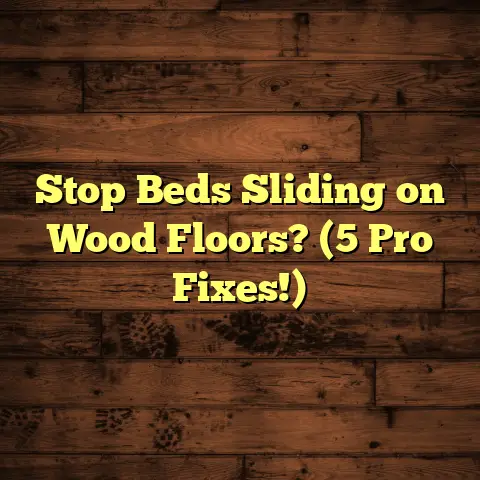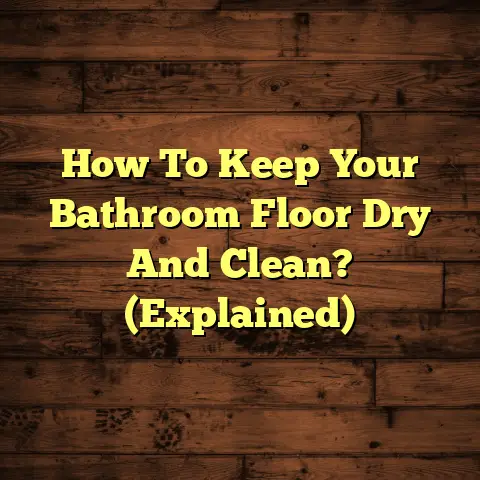Rubber Rugs on Laminate Safe? (5 Install Fails!)
In a world where comfort and style are
paramount, the juxtaposition of rubber rugs
over stylish laminate floors poses an
intriguing dilemma: can safety coexist with
aesthetics?
It’s a question I, as a seasoned
flooring contractor, get asked all the time.
And honestly?
The answer isn’t always
straightforward.
Stick with me, and we’ll
unravel this compatibility puzzle together.
Section 1: Understanding the Basics of Laminate Flooring
Let’s start with the foundation: laminate
flooring.
What exactly is it?
Well, think of
it as a clever composite, a multi-layered
sandwich designed to mimic the look of
natural materials like wood or stone.
Typically, you’ve got a high-density fiberboard (HDF) core, a decorative photographic layer giving it that realistic appearance, and a tough, transparent wear layer on top for protection.
What makes laminate so popular? Several things!
-
Durability: It’s surprisingly resilient, standing up to everyday wear and tear pretty well.
-
Ease of Maintenance: Cleaning is a breeze – usually just a quick sweep or mop.
-
Cost-Effectiveness: Compared to solid hardwood or natural stone, laminate is generally much more budget-friendly.
But how does laminate stack up against other
flooring options?
Unlike hardwood, it’s less
susceptible to scratches and dents.
And
compared to tile, it’s warmer underfoot and
easier to install.
However, it’s not waterproof like some types
of tile, and it doesn’t have the same luxurious
feel as real wood.
See the table below for a
comparison.
Section 2: The Appeal of Rubber Rugs
Now, let’s talk about rubber rugs.
Why are
they such a popular choice for many homes?
First and foremost, they’re known for their
non-slip properties.
This makes them ideal
for areas where safety is a concern, like
kitchens, bathrooms, or entryways.
Plus, they often provide cushioning, which can be a welcome relief for tired feet, especially if you’re standing for long periods.
And let’s not forget about ease of cleaning.
Spills and messes are easily wiped away,
making them a practical choice for busy
households.
You can find rubber rugs in a wide array of
styles, colors, and designs these days.
From
simple, functional mats to more decorative
options that mimic the look of woven textiles,
there’s something to suit almost any aesthetic.
I’ve seen them used everywhere – in front of kitchen sinks, in mudrooms to catch dirt and debris, and even in home gyms to provide a non-slip surface for workouts.
Section 3: The Compatibility Conundrum
Okay, here’s where things get interesting.
Can
rubber rugs and laminate flooring truly coexist
harmoniously?
It’s a bit of a mixed bag.
On the one hand, a rubber rug can protect your
laminate floor from scratches and scuffs,
especially in high-traffic areas.
It can also
add a layer of comfort and reduce noise.
However, there are potential drawbacks to
consider.
One major concern is moisture
retention.
Rubber is not breathable, so if
moisture gets trapped between the rug and the
laminate, it can lead to problems like mold
growth or warping.
Another issue is the potential for adhesive
properties.
Some rubber rugs can leave
behind a sticky residue that’s difficult to
remove from laminate flooring.
And then there’s the question of VOCs (Volatile
Organic Compounds).
Some rubber rugs,
especially those made from synthetic rubber,
can emit VOCs, which can affect indoor air
quality.
According to the EPA, VOCs can
contribute to health problems.
It’s a balancing act, folks. You’ve got to weigh the benefits against the risks.
Section 4: Five Common Installation Fails
Over the years, I’ve seen my fair share of
flooring mishaps.
Here are five common
installation fails I’ve encountered when it
comes to rubber rugs and laminate:
Fail #1: Improper Surface Preparation
This is a big one!
Before you even think about
laying down that rubber rug, you must make
sure your laminate floor is clean, dry, and
free of debris.
I cannot stress this enough.
If you skip this step, you’re setting yourself
up for trouble.
Dust, dirt, or spills trapped
underneath the rug can create an uneven
surface, leading to poor adhesion and potential
damage to the laminate.
I once had a client who installed a rubber rug
over a laminate floor without properly cleaning
it first.
Over time, the trapped dirt scratched
the laminate, leaving unsightly marks.
Trust
me, a little elbow grease upfront can save you a
lot of headaches (and money) down the road.
Fail #2: Choosing the Wrong Type of Rubber Rug
Not all rubber rugs are created equal, my
friends.
There are variations in thickness,
material, and intended use, and choosing the
wrong one can spell disaster for your laminate
floor.
For example, a thick, heavy rubber mat designed
for outdoor use might be too abrasive for
delicate laminate.
Similarly, a rug made from
low-quality rubber could leach chemicals or
leave behind a sticky residue.
Always read the product descriptions carefully
and choose a rug that’s specifically designed
for indoor use and compatible with laminate
flooring.
Consider the rug’s backing material
too.
Some backings are more likely to trap
moisture than others.
Fail #3: Ignoring the Need for Ventilation
Ventilation is key, especially when you’re
dealing with new rubber rugs.
These rugs often
emit odors and VOCs when they’re first
unpacked, and proper ventilation can help
dissipate these chemicals.
Inadequate airflow can also lead to trapped
moisture, as we discussed earlier.
This can
create a breeding ground for mold and mildew,
which can damage your laminate floor and affect
your indoor air quality.
When you first install a rubber rug, open
windows and doors to allow for plenty of
ventilation.
You might even consider using an
air purifier to help remove VOCs from the air.
Fail #4: Overlooking Manufacturer Guidelines
This might seem obvious, but you’d be surprised
how many people ignore manufacturer
guidelines.
Both the rug and the laminate
flooring will come with instructions, and
it’s crucial to follow them carefully.
These guidelines will provide valuable
information about proper installation techniques,
recommended cleaning products, and potential
limitations.
Ignoring them could void your
warranty or accelerate the wear and tear of
your laminate floor.
I remember one instance where a client used the
wrong type of cleaning solution on their
laminate floor after installing a rubber rug.
The solution damaged the wear layer, leaving
the floor looking dull and faded.
A costly
mistake that could have been avoided by simply
reading the instructions!
Fail #5: Failing to Account for Temperature Changes
Temperature fluctuations can have a significant
impact on both rubber and laminate materials.
Rubber tends to expand and contract with
temperature changes, and this can put stress
on the laminate floor underneath.
Similarly, laminate flooring can warp or buckle
if exposed to extreme temperature variations.
Failing to account for these changes can lead
to damage to your flooring.
If you live in an area with significant
temperature swings, consider using a thinner
rubber rug or one with a breathable backing.
You might also consider using a rug pad to
provide a buffer between the rug and the
laminate floor.
Section 5: Conclusion
So, are rubber rugs on laminate safe?
As we’ve
explored, it’s not a simple yes or no answer.
It’s a nuanced situation that requires careful
consideration of various factors.
We’ve looked at the basics of laminate
flooring, the appeal of rubber rugs, and the
potential compatibility issues between the two.
We’ve also delved into five common installation
fails that can lead to problems.
Ultimately, the decision of whether or not to
use a rubber rug on your laminate floor is a
personal one.
Weigh the pros and cons, do your
research, and follow the guidelines we’ve
discussed.
Remember the initial paradox: can safety
coexist with aesthetics?
Yes, it can.
But it
requires knowledge, diligence, and a healthy
dose of common sense.





